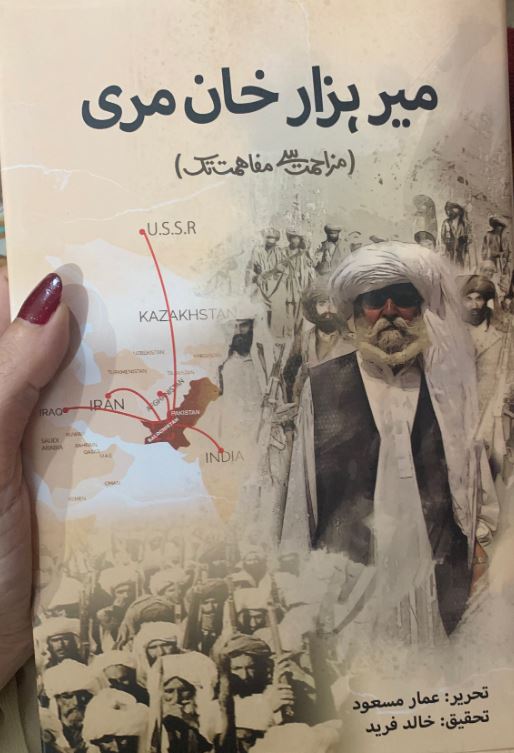
Ammar Masood’s recent book Mir Hazar Khan Marri—Muzahimat sy mufahimat Tak has caught the attention of those who closely watch the Baluchistan chaos. The book tells the story of a rebel fighter who went to Afghanistan in the 1980s and launched attacks on the military personnel there. Later, under Prime Minister Benazir’s amnesty scheme, he returned to his normal life. His descendants now provide services in the state’s institutions, and one of his grandsons is a high-ranking military officer.
Prominent themes of the book:
The book sends a powerful message to those who live in deception, encouraging them to fight against the state. Adopting a rebellious attitude cannot solve the problems; proper dialogue and consensus are necessary. Baluchistan’s chaos, anarchy, and separatist movement harm the province and nation. Baluchistan’s strategic and economic significance is determined by its location.
Baluchistan is Pakistan’s largest province by area, with a population of approximately 14.89 million. The province’s growth has coincided with the region’s basic developmental challenges. Despite having the highest literacy rate (41%), it remains the least-read material in the area. Baluchistan has approximately 15,096 educational institutions, most of which are primary schools. There are 1,661 health facilities in Baluchistan, including dispensaries, primary health centres, and hospitals.
Despite their efforts to allocate all the necessary resources, the authorities could not fully implement the strategy because they needed to maintain strategic depth against their adversaries. The authorities first established this strategy during the pre-partition of the subcontinent, dividing India and Pakistan, and the policy remains in effect today. Consequently, Baluchistan is still considered the most underdeveloped province in Pakistan. Despite efforts to enhance education and healthcare, progress must be faster and more balanced.
Separatist groups in Baluchistan, like the Baluch Liberation Army (BLA), use deceitful tactics to mislead the younger generation, inflating the extent of government oppression. They use dissatisfaction with capitalization, resource exploitation, and Baluchistan’s claim to abundant natural resources as central factors in their grievance. The BLA has been involved in a large number of attacks, including the most recent in August 2024, when they established a complex assault in which 70 people were attacked. These organizations often overdramatize state oppression and suggest liberation as the most appropriate answer, though they are unpopular and are primarily looking to get concessions.
The story of Mir Hazar Khan demonstrates the government’s commitment to providing equal resources while insisting that dialogue and inclusivity are the only ways to solve every problem. Once marginalized by society, his family achieved success through constructive engagement with state institutions, highlighting the benefits of cultivating a positive relationship with the government. The Mir Hazar family has received recognition and awards for prioritizing education and community development, demonstrating that it is possible to succeed through cooperation and loyalty to the authorities. Their situation underscores the notion that peaceful complaint resolution methods and cultivating a team spirit are prerequisites for sustainable development and mutual respect through cooperation.
Some of Balochistan’s sardars and feudal lords oppose setting up a complete state writ because it will likely make them lose power and affect their interests. These politicians wield considerable power and employ a repressive method of obedience to prevent resistance from the people. They portray themselves as decent politicians who bear sole responsibility for the people’s suffering. This strategy maintains its position at the top and prevents the state from considering the regions seriously. By persuading the masses to believe that the state has isolated the area from the well-established state, the sardars ensure that no one notices their exploitative practices. This, in turn, maintains the region’s dependence on them and prolongs its decline.
Conclusion:
Pakistan’s government is committed to the development and prosperity of Baluchistan. However, achieving this goal is only possible with the active backing and support of the province’s residents. The people of Baluchistan will not let separatists and feudal lords betray them with rhetoric. This only serves to foster mistrust and division among the Baluch people. The Baluch people can create a path to ensure long-term development, leading people to a better life through joint efforts and non-acceptance of these discordant narratives. The government and local support will transform Baluchistan into a prosperous land from which all residents will benefit.
Mir Hazar’s life strongly suggests that no one can fight against the state. In case of grievances or misunderstandings, the stakeholders must bring the issue to the table and solve it through inclusive dialogue and involving all the authorities.
